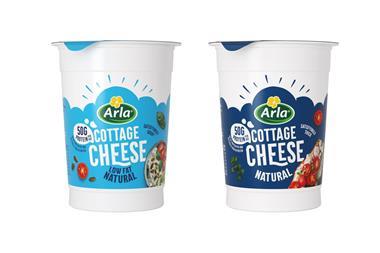Are major UK multiples missing out on a chance to add some sparkle to their customers' shop? Many shoppers view good cheese as an indulgent treat for which they are prepared to pay good money.
British Cheese Board secretary Nigel White says: "There is a huge opportunity to grow retail cheese volumes through a fundamental rethink of the way the category is merchandised. Our research suggests marketers and merchandisers are getting it wrong in terms of packaging and the fixture.
"Consumers are confused, they believe there is a limited choice of cheese, and that all cheeses look and taste the same."
He accuses retailers of failing the consumer and damaging the cheese industry. "We need to remind people of the immense range of more than 400 cheeses that British cheesemakers turn out, as well as the wealth of continental cheeses."
White urges everyone to challenge the traditional segmentation of the market, understand the needs of shoppers, and get the consumer back into the category again.
In large measure, anyone selling cheese is pushing at an open door 98% of UK households buy cheese at least once a year and 81% buy it once every four weeks. But White thinks a shift in focus is needed to reflect changing consumption patterns. "We need to look at specifically targeting single person meals which currently account for 31.5% of all cheese meal occasions."
Cheesemakers feel much the same. "Wastage bothers some retailers more than sales," says one. "They're playing safe rather than trying to realise the potential of a line."
Practised counter hands will spot slower moving cheeses in time to put out some samples. Consumers may be developing a taste for adventure, but footfall at the serveover also needs to be indulged in some way.
As one manufacturer puts it: "If multiples make the checkouts so much more prestigious than any other part of the shop, what chance has the cheese counter got? All the good staff tend to migrate to the checkouts where the pay is better. That's where they want to be."
True, every customer passes through the supermarket checkout, but they would spend even more if they also stopped at the cheese counter.
"A cheese counter is added value to the store, it's an area where people communicate, where new developments, like dessert cheeses, can be tried out," says Andrew Wilson, Dairy Crest's roving cheese consultant.
"But people don't want to queue. That said, there are still people who will only go to the deli to have their cheese cut for them. The deli still plays a large part.
"Cheese counter staff need to be multiskilled to cover for other departments as well as their own," says Wilson. "If you go back a few years you had dedicated cheese staff. Now people are moving from cooked meats to cheese to pies and bacon.
"The deli is an expensive part of the world and staff are expensive." This means staffing levels will be a finely judged matter. The cover required will vary across a typical week.
"It's a difficult job to train them and the biggest problem is it's a group of people that tends to change more often than full-timers.
"Training is important, but will people give it the time and expense to make sure staff are trained?" asks Wilson, who has spent the past 15 years promoting good practice and educating deli staff.
He adds: "There is definitely a need for product knowledge. When we go out to buy a pair of shoes, we expect the shop assistant to know about footwear. So when folk buy cheese, they sometimes ask what puts the holes in Emmental or what makes Red Leicester red. It's all basic stuff, but it doesn't hurt to know it."
Staff turnover is not only a factor at store level currently there are no fewer than three multiples where new cheese buyers are getting to grips with cheese. The customer wants to know more about all food purchases, not just cheese and stores will lose sales if this service cannot be given.
"There's a lack of knowledge and a lack of interest. But cheese is so simple to do!" exclaims Wilson. "The trouble is that it gets stuck in the fridge. It comes out cold and tastes like cotton wool."
The law on the subject is very difficult to interpret, Wilson concedes. The regulations insist on due diligence: "But how you apply it is your problem." The crucial skill is in making judgements that will allow both cheeses and customers to be at their best, without compromising food safety requirements.
Within the major UK multiples and the independents covered by Taylor Nelson Sofres Superpanel reporting [52 weeks to 14 November 1999], specialist cheeses (not counting handmade Farmhouse Cheddars) have a 28% share of a £1.27bn market, recording a 2% lift in value and 6% in volume.
However, the mainstream retailers' total tonnages are put at 280,000t by TNS for a 52-week period, while MAFF figures for the first three quarters of last year put the UK total adjusted supply at 429,000t, without counting the Christmas peak for Stilton.
Nevertheless, specialist cheeses account for about one quarter of TNS recorded tonnages, counting handmade Farmhouse Cheddars as well as additive cheeses made with White Stilton and other crumbly territorials that would otherwise be classified as processed cheeses.
Cheddars account for just over half of total cheese sales, but volumes and interest are both slipping. The British cheese shopper is at last moving away from undifferentiated yellow blocks and is prepared to trade up for premium products if they find someone who can take the time to tell them what they get for their money.
Serveover cheese sales account for 17% of TNS recorded volumes. But if retailers feel that the counter is not progressing as well as they would like, they should realise that more cheese than ever is being pulled into other growing sectors, such as ready meals and industrial ingredients.
These ingredients should not be thought of automatically as down-grades or failed retail products. Over the last decade, ready meal manufacturers have moved from an undistinguished range of flavours to more sophisticated lines.
While marketing experts talk of following consumers' lifestyles to gain share of stomach', cheese is already doing it, quietly moving around the country in huge tonnages, not all of it going through supermarkets.
Firms such as Ash Manor have grown steadily with this trend the Wrexham based firm is poised to open a 10,000 sq ft extension to its grating, slicing and dicing operation in May. "There is a need to come up with new ideas on a regular basis," says sales director Nigel Wilkin.
This is as necessary for Ash Manor as it is for its manufacturing customers, who need to develop their range, too.
Even outwardly simple notions such as finely slicing cheese can seed ideas for new product development. "We can slice Mozzarella so thinly that we can fold it over and even fill it," says joint md Paul Smith-Palmer.
But the most saleable ingredient in the range is a liquid cheese made from a blend of Swiss Emmental and Gruyère, which retains its true flavours.
The potential for ready meals and elsewhere is almost limitless.
Says Wilkin: "There is obviously a need to educate people and to let them have the chance to be aware of how different cheeses can be used."
As well as ingredients for ready meals, consumers are turning to cheese as a snack food.
Small portion packs, not to be confused with pick 'n' mix lines, are being developed for lunchboxes and people eating on the move. Two finger packs are just one format for promoting cheese.
Scanning software now manages the promotional pricing at the till, allowing chilled and ambient products to be promoted together at the same time, as well as generating footfall between two store locations (eg between the dairy case and cheese crackers).
The promotional potential of British PDO cheeses are being discussed at some length at present, with a view to some form of combined promotion in the medium term.
While the hazards of mixing blue cheeses with other varieties preclude putting them together in one pack, a well run promotion could generate a lot of footfall.
Even if the consumer looks further afield for inspired food, retailers can still earn a share of this special occasion shopper's spend. n
{{FOCUS SPECIALS }}
Close menu
- Home
- Retail & Wholesale
-
Products & Suppliers
- Back to parent navigation item
- Products & Suppliers
-
Product Categories:
- Back to parent navigation item
- Product Categories:
- Alcoholic drinks
- Bakery
- Cereals & breakfast
- Cheese
- Chicken & poultry
- Chocolate
- Confectionery
- Crisps, nuts & snacks
- Dairy
- Fish
- Fresh produce
- Frozen
- Household
- Meat
- Own Label
- Sauces & condiments
- Seasonal
- Soft drinks
- Vaping
- Vegan & plant-based
- World foods
- Suppliers
- People
- Reports & Data
-
Topics A-Z
- Back to parent navigation item
- Topics A-Z
-
Popular topics:
- Back to parent navigation item
- Popular topics:
- Cost of living crisis
- Crime
- Deposit Return Schemes
- Finance
- Government & Regulation
- Health
- Inflation
- Loyalty
- Marketing
- Mergers & Acquisitions
- New Product Development
- Sourcing
- Supply chain
- Sustainability & environment
- Technology
- Ultra Processed Foods
- Vaping
- A-Z all topics
- Content by type:
- Events
- Ask iA (beta)
- Subscribe now
Sign in to comment on this article
Not logged in before? Register for FREE guest access today.
You will be able to:
- Read more stories
- Receive daily newsletters
- Comment on stories
Advert















No comments yet